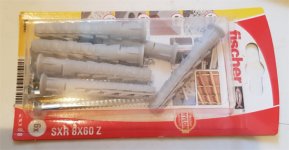The brackets currently on the stair railing are loose in the wall. I think the tapcons weren't well installed and the brick might have cracked from the holes being so close.
I want to replace the brackets with some new ones so I've been going about gathering materials. Instead of tapcons, I'm going to use some heavier duty anchors (Fischer duopower) with 2.5" #10 screws.
The anchors themselves are only about 1.5" long. What I was thinking about was this: if I put some wood deeper in the hole, behind the anchors, then can the screw also bite into that and thus be more securely embedded? Or would this be relatively meaningless and only add further complications?
I want to replace the brackets with some new ones so I've been going about gathering materials. Instead of tapcons, I'm going to use some heavier duty anchors (Fischer duopower) with 2.5" #10 screws.
The anchors themselves are only about 1.5" long. What I was thinking about was this: if I put some wood deeper in the hole, behind the anchors, then can the screw also bite into that and thus be more securely embedded? Or would this be relatively meaningless and only add further complications?

